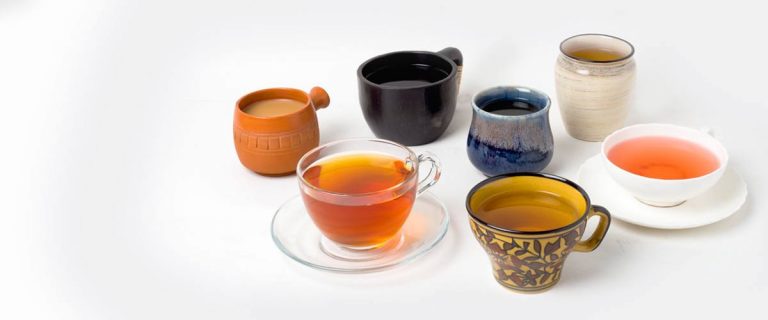Every Sherlock needs a Watson. And every tea, a good tea cup! From the time a tea leaf gets plucked from the shrub, every little thing it comes in contact with alters its taste and quality. The last step in this journey from plant to serveware is the cup itself, so it’s time you took a closer look at what is in your hands and how it’s affecting your tea drinking experience.
What are the qualities of good tea serveware?
- It should be non-porous: Simply because a porous material will hold in different flavours and aromas; all detrimental to the taste of the tea you drink.
- It should allow the tea to cool slowly: A cup with a wide rim cools tea faster, while a tall, narrow one keeps it hot longer and concentrates the aroma. Thin cups lose heat faster while ceramic retains heat longer than glass.
- It should have a thin lip: It is essential that your chosen tea cup have a thin lip so that the drink can roll off the cup’s edge and onto your tongue more easily.
- It should be safe chemically: While we do not recommend plastic cups, if you must use them, ensure that they are BPA (bisphenol A) free.
What material make the best tea serveware?
Ceramic
Ceramic is widely used in teaware manufacture. Ceramic refers to the baked clay pottery made in kilns but includes stoneware, porcelain and terracotta. They are a popular choice both in-terms of aesthetics and usage. Ceramic retains heat for a longer period of time due to its porosity, has resistance to higher temperatures, and eliminates any metal or other material tastes seeping into your tea.
Porcelain and Bone China
Bone china and porcelain cups (which are also sometimes clubbed under ceramic) have been used for ages as teaware, and are the material of choice when it comes to drinking tea. When made the right way, porcelain is amazingly non-porous, and the vitrified glaze makes it non-reactive as well. Bone china is like porcelain, except in that it uses bone ash mixed with clay. It is what most British teaware is made of, and British scientists opine that the smooth shape of the bone china and porcelain cups prevents tannin in the tea from sticking to the side, thus preserving the body of the tea.
Glass
Glass cups meet all the criteria for the ideal teaware listed above. Glass pitchers are used for brewing tea as well. Vitrified glass does not react with the tea at all, but it can lose heat quickly depending on its thickness. Borosilicate glass is a good choice, almost as good as porcelain and less fragile. Double walled glass cups are an inspired choice where the inner wall retains the heat while the outer one makes it easier to hold. What”s more, there’s something to how the tea looks through the two layers of glass.
Stainless Steel
Stainless steel cups are the hardiest of the lot, but the material does not always live up to its name. Leaching from stainless steel kitchenware has been a concern of late as it was found out that scratched stainless steel utensils can leach iron and nickel into the food. Plus, there is the issue of stainless steel cups getting too hot for sipping in a short time. Due to its inherent heat conductivity, the metal transfers heat to the lip much faster than, say, a porcelain cup, making it slightly inconvenient to drink from.
Plastic
Plastic cups, like stoneware and clay cups, are not recommended by tea connoisseurs at all. Use them if you must, but know that not all plastics are chemically inert and can leach toxic elements on exposure to high heat.

Comments are closed.